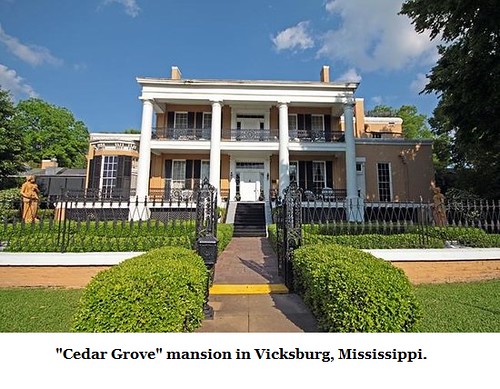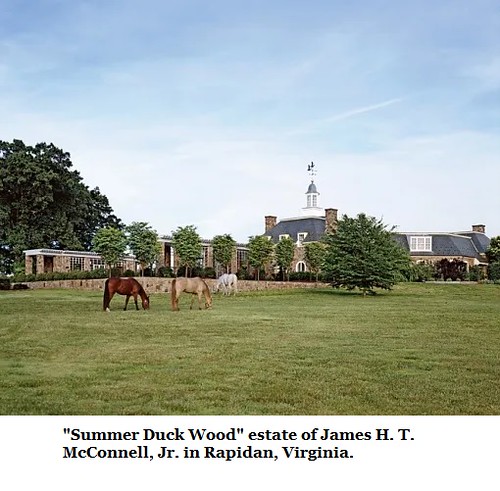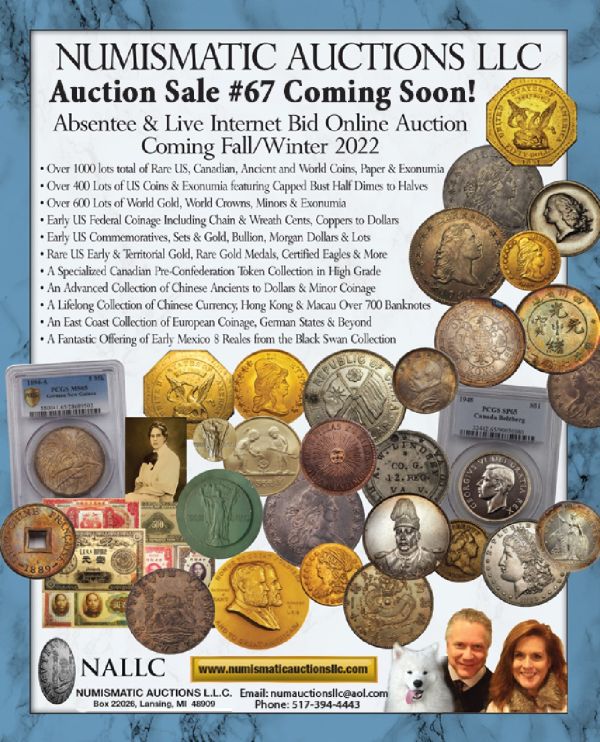
PREV ARTICLE
NEXT ARTICLE
FULL ISSUE
PREV FULL ISSUE
V25 2022 INDEX E-SYLUM ARCHIVE UNPUBLICIZED MYSTERY COLLECTIONSAmerican Numismatic Biographies author Pete Smith submitted this article on lost, unknown or unpublicized mystery collections. Thanks! Can readers add anything about these collectors or their collections? -Editor
Unpublicized Mystery Collections
In his book, The Rare Silver Dollars Dated 1804, Q. David Bowers describes two mysterious
owners of the
There is still another mystery that Bowers did not mention.
George M. Klein Sr. (1844-1923)
Although George Klein may have been relatively unknown in numismatic circles, he was very prominent in the Vicksburg area. George Marion Klein was born in Vicksburg. Mississippi, on July 5, 1844, the son of John Alexander Klein (1812-1884) and Elizabeth Bartley Day Klein (1826-1909). The family was wealthy and socially prominent.
The father, John Alexander Klein, moved to Vicksburg in 1836. He established a jewelry
business there and expanded into lumber investment. Around 1840 he built a home for his family
he named George took one of his servants with him as he served in the Confederacy during the Civil War. After the war he attended Heidelberg University in what is now Germany. He married Louise Harrison Balfour (1848-1909) in 1868. They had eleven children, of which four predeceased him. After the war, John expanded his investments in railroads and banking. The Mississippi Valley bank was formed in November 1868 with a capitalization of $150,000. George M. Klein was cashier at the Mississippi Valley bank with his father as president until he retired in 1881. George was later president with his brother John A. Klein, Jr. as Cashier. In 1880 George succeeded his father as treasurer of the Church of the Holy Trinity of Vicksburg. The Mississippi Valley Bank issued bonds to finance completion of the church building. Grain speculation by A. K. Bonham & Co, of St. Louis resulted in large losses and the bank became insolvent in November of 1883. The bank was unable to pay the interest on the church bonds and George was replaced as church treasurer. This was just one of many unpaid creditors. The Mississippi Valley Bank was the largest bank in Vicksburg at the time and its failure caused great distress in the community. The church was scheduled to be sold at auction in 1887 to pay off the debts but was saved by a presale settlement. Klein vowed to make up all the losses and consigned his coin collection to pay off debts.
He died at Vicksburg on December 22, 1923, and is buried at Cedar Hill Cemetery in Vicksburg
with his parents, spouse and children. Another section of the cemetery is Klein acquired the Davis 1804 dollar for $1200 from John Hazeltine in 1883. It was sold as part of the Vicksburg Collection by W. Elliott Woodward on March 21-25, 1888. With four Woodward sales, the Klein collection was dispersed.
James H. T. McConnell, Jr.
James H. T. McConnell, father and son, were named for an ancestor, former Virginia Governor, James Hoge Tyler (1846-1925). The father, McConnell Sr. (1914-1989) was married to Jean Ellen Dupont, daughter of William DuPont and brother of John DuPont. James H. T. McConnell. Jr. was born on September 1, 1949. He graduated from the University of Virginia; was married to anthropologist Mary Carter McConnell and divorced. His interests include investment management, horse breeding and philanthropy. He acquired the Davis 1804 dollar through Stack's on November 21, 1971, when he was 22 years old. It was previously owned by Norton Simon.
The Alabama Banking Association Collection
While researching Purnie Moore, I came across newspaper articles about an exhibit touring through banks in Alabama.
The exhibit had twelve panels with coins framed under glass. These were generally shown in a bank lobby for a day. They were first shown on July 25, 1953, and had been purchased the previous winter. Another article stated that they were purchased from the family of Raymond Birchett of Jackson, Mississippi. By 1969, the display had grown to fourteen panels. Museum Director Dr. Walter B. Jones arranged for funds to acquire additional small collections to add to the Museum's collection around 1982.
Raymond Chandler Birchett (1902-1974)
Raymond Chandler Birchett was a prominent architect. He was born in Vicksburg. Mississippi, and lived in Jackson, Mississippi in 1953. The family trees for George Klein and Raymond Birchett are well documented. George Marion Klein (1844-1923) had a sister, Clara Estelle Klein (1848-1932). She married Dr. Theophilus G, Birchett (1835-1904). They had a son Dr. John Alexander Birchett, Sr. (1867-1938) who was the father of Raymond Chandler Birchett (1902-1974). Thus, George Klein was the great-uncle of Raymond Birchett.
The Ongoing Mysteries
The Alabama Banker's Association coin collection was shown at the Alabama Numismatic Society convention in 1976, promoted by Purnie Moore. It was a newspaper article about that event that brought the collection to my attention. Mystery #1: What happened to the collection? I did not find any mention of it on the Alabama Museum of Natural History website. My email request for information received no response. Mystery #2: Why would it be given to a natural history museum when it is not natural history? Mystery #3: If the Klein (Vicksburg) collection was sold at auction in the 1880's, how could the same collection be passed through the family estate and still be one of the finest in the country in 1952? Everyone loves a good mystery, but at The E-Sylum we love solving them even more. Can anyone help with these questions? -Editor
To read the earlier E-Sylum article, see:
Wayne Homren, Editor The Numismatic Bibliomania Society is a non-profit organization promoting numismatic literature. See our web site at coinbooks.org. To submit items for publication in The E-Sylum, write to the Editor at this address: whomren@gmail.com To subscribe go to: https://my.binhost.com/lists/listinfo/esylum All Rights Reserved. NBS Home Page Contact the NBS webmaster 
|


